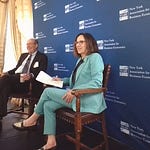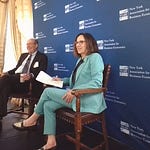When Diane Swonk looks “under the hood” of the August CPI report, she is not disappointed as some in the markets were by the latest numbers.
”First of all, the overall report, its great that it's at the lowest level since February 2021. Does it get us to a half percent cut by the Federal Reserve? No, it gets us to that quarter percent cut,” she says. “That's where the unanimous vote will be, although there will be discussion, because I think some who wanted to cut in July will still be arguing for a half percent cut. So we’ll see that in the minutes.”
”But nonetheless, this is a quarter percent cut and I think that's important,” she adds.
”Looking under the hood, the good news in the report was how much goods prices, particularly baked goods that we finance, things like appliances, furniture used, vehicle prices. Those were down in the overall index at the fastest pace of December 2003.”
Diane is also heartened that food at the grocery store “was pretty much flatlined and food going out. It moderated a bit, but still it's up. And we all know that from going out to eat.”
”But what's more important was the non-durable goods prices outside of that also saw big box discounters roll back some of those prices,” she says adding, “Where prices are looking stickier is in the service sector.”
And this gets us to shelter prices, one of the stickiest parts of the CPI.
”We know shelter cause that's a lagging indicator, but yet that is not come down and there is a lack of affordable housing out there,” she says. “And we know that even though it's come down from the scorching high levels we saw earlier, it's still running far too high for the Federal Reserve. The service sector also showing some buoyancy in everything from lodging to airfares.”
The big plus in the CPI report was, as Diane stressed, the headline CPI falling to 2.5% y/y from 2.9% in August. The minus was that the core CPI that takes out food and energy rose to3.2% y/y with the 3-month annualized rate rising to 2.1% from 1.6% in August, while the core CPI that takes out food and energy actually moved up to 3.2% y/y in July.
So what does this mean for the Fed?
”What we expect to see is that the Fed is going to stay sort of at this quarter point November as well,” she says. “We could see a half percent (cut) in December. And much of that depends on how weak employment it gets.”
”I don't see a recession out there, but we're talking about employment right now. It's averaging 160,000 on a three month moving average basis,” she adds. “That's not statistically really different from zero. And we do see additional weakness as we move towards the election.
Diane and her team she the coming election potentially weighing on the markets no matter who wins.
“62% of CEOs that we survey at KPMG have said the election really is pretty consequential,” says. “There's a lot of uncertainty regarding policy post election. Now, no matter what happens, we know this is a close election, but there's concern on everything from regulation to tariffs to immigration policy, a whole spectrum of things on both sides of the aisle. And we're probably pretty likely to get a split Congress once again as well.”
“So the question then becomes, whoever wins the White House, what kinds of policies could they actually implement going forward? All that has led to a hesitancy in an uncertainty that could exacerbate the weakness that we see in employment.”
Diane stresses that importantly consumers are still spending.
”One of the things I point out is that consumers are discerning now, but not defeated,” she adds. “And that's a very important place to be, is that you're forcing those discounts out there and they're sort of withheld their wallets until they get discounts.
“That's exactly what the Federal Reserve wants to see for a soft landing,” she says. ‘What we don't want to see is those discounts sort of morph into larger layoffs and a more broader weakening in the labor market.
Have a look and a listen. We also talked about the the new set of Dot Plots could look like at the Fed’s meeting next week. She thinks they will be divided between the doves who want to more hikes than had been forecast in June versus the hawks whose rate cut doors are that wide open.
Diane Swonk
Chief Economist, KPMG US
Diane Swonk is one of the most respected macroeconomists, who maintains a unique perspective on the inner workings of Main Street as well as Wall Street. She is an expert on the economics of the labor market, monetary policy and structural changes that are distinct from economic cycles.
Diane Swonk began her career with money-center bank First Chicago. She climbed from entry-level to Director of Research and Chief Economist at Bank One, the merged bank. She spent more than a decade as Senior Managing Director and Chief Economist at the financial services firm, Mesirow Financial. Before joining KPMG, Diane had her own economics consulting firm and worked at Grant Thornton. Diane now heads up the growing economics team at KPMG to serve partners and clients, and to engage with the media to help showcase the firm’s achievements.
She has served as an advisor to the National Economic Council (NEC) on a nonpartisan basis. She regularly briefs the regional Federal Reserve banks and the Board of Governors in Washington, DC. She has provided Congressional testimony on income inequality and how to preserve and bolster the quality of government economic statistics. She is on the Advisory Board for the Bureau of Economic Analysis, of the Census Department.













Share this post